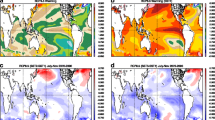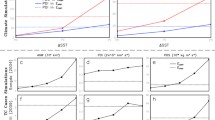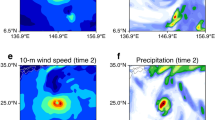Abstract
It has been challenging to project the tropical cyclone (TC) intensity, structure and destructive potential changes in a warming climate. Here, we compare the sensitivities of TC intensity, size and destructive potential to sea surface warming with and without a pre-storm atmospheric adjustment to an idealized state of Radiative-Convective Equilibrium (RCE). Without RCE, we find large responses of TC intensity, size and destructive potential to sea surface temperature (SST) changes, which is in line with some previous studies. However, in an environment under RCE, the TC size is almost insensitive to SST changes, and the sensitivity of intensity is also much reduced to 3% °C−1–4% °C−1. Without the pre-storm RCE adjustment, the mean destructive potential measured by the integrated power dissipation increases by about 25% °C−1 during the mature stage. However, in an environment under RCE, the sensitivity of destructive potential to sea surface warming does not change significantly. Further analyses show that the reduced response of TC intensity and size to sea surface warming under RCE can be explained by the reduced thermodynamic disequilibrium between the air boundary layer and the sea surface due to the RCE adjustment. When conducting regional-scale sea surface warming experiments for TC case studies, without any RCE adjustment the TC response is likely to be unrealistically exaggerated. The TC intensity–temperature sensitivity under RCE is very similar to those found in coupled climate model simulations. This suggests global mean intensity projections under climate change can be understood in terms of a thermodynamic response to temperature with only a minor contribution from any changes in large-scale dynamics.
摘要
预测热带气旋的强度、结构特征和破坏力对气候变化的响应始终充满挑战. 本文利用大气数值模式对比了进行背景场辐射对流平衡调整(Radiative-Convective Equilibrium)前后, 热带气旋对海表温度的响应. 研究发现, 如果背景场没有进行辐射对流平衡调整, 气旋强度、大小和破坏力指标均对海面升温产生较强响应. 这一结果与前人结论相似. 然而, 若背景场在模拟气旋之前被调整到辐射对流平衡状态, 模拟的气旋尺寸几乎对海面升温不敏感, 且气旋强度的敏感度也大幅下降至3-4%/C. 进一步研究发现, 气旋特征对海表升温敏感度下降可归因为在辐射对流平衡环境中减弱了的海气界面热力学不平衡性(thermaldynamic disequilibrium). 因此, 在进行热带气旋的海表温度敏感性实验时, 若不先对背景场进行辐射对流平衡调整, 那么所模拟的气旋敏感性会被放大. 与耦合气候模式对比后发现, 辐射对流平衡调整后得到的热带气旋对海表温度的敏感性与耦合气候模式模拟得到的敏感性基本一致. 该发现说明:在全球气候变化背景下, 热带气旋强度对海表温度变化的响应主要受控于热力学过程而非大尺度动力学过程.
Article PDF
Similar content being viewed by others
Avoid common mistakes on your manuscript.
References
Bender, M. A., T. R. Knutson, R. E. Tuleya, J. J. Sirutis, G. A. Vecchi, S. T. Garner, and I. M. Held, 2010: Modeled impact of anthropogenic warming on the frequency of intense Atlantic hurricanes. Science, 327, 454–458, https://doi.org/10.1126/science.1180568.
Bretherton, C. S., P. N. Blossey, and M. Khairoutdinov, 2005: An energy-balance analysis of deep convective self-aggregation above uniform SST. J. Atmos. Sci., 62, 4273–4292, https://doi.org/10.1175/JAS3614.1.
Chan, J. C. L., 2005: The physics of tropical cyclone motion. Annual Review of Fluid Mechanics, 37, 99–128, https://doi.org/10.1146/annurev.fluid.37.061903.175702.
Chan, J. C. L., and R. T. Williams, 1987: Analytical and numerical studies of the beta-effect in tropical cyclone motion. Part I: Zero mean flow. J. Atmos. Sci., 44, 1257–1265, https://doi.org/10.1175/1520-0469(1987)044<1257:AANSOT>2.0.CO;2.
Chavas, D. R., and K. Emanuel, 2014: Equilibrium tropical cyclone size in an idealized state of axisymmetric radiative–convective equilibrium. J. Atmos. Sci., 71, 1663–1680, https://doi.org/10.1175/JAS-D-13-0155.1.
Courtney, J., and J. A. Knaff, 2009: Adapting the Knaff and Zehr wind-pressure relationship for operational use in Tropical Cyclone Warning Centres. Australian Meteorological and Oceanographic Journal, 58, 167–179, https://doi.org/10.22499/2.5803.002.
Dudhia, J., 1989: Numerical study of convection observed during the winter monsoon experiment using a mesoscale twodimensional model. J. Atmos. Sci., 46, 3077–3107, https://doi.org/10.1175/1520-0469(1989)046<3077:NSOCOD>2.0.CO;2.
Emanuel, K., 2003: Tropical cyclones. Annual Review of Fluid Mechanics, 31, 75–104, https://doi.org/10.1146/annurev.earth.31.100901.141259.
Emanuel, K., 2005: Increasing destructiveness of tropical cyclones over the past 30 years. Nature, 436, 686–688, https://doi.org/10.1038/nature03906.
Emanuel, K., 2007: Environmental factors affecting tropical cyclone power dissipation. J. Climate, 20, 5497–5509, https://doi.org/10.1175/2007JCLI1571.1.
Emanuel, K. A., 1986: An air-sea interaction theory for tropical cyclones. Part I: Steady-state maintenance. J. Atmos. Sci., 43, 585–605, https://doi.org/10.1175/1520-0469(1986)043<0585:AASITF>2.0.CO;2.
Emanuel, K. A., 1991: The theory of hurricanes. Annual Review of Fluid Mechanics, 23, 179–176, https://doi.org/10.1146/annurev.fl.23.010191.001143.
Emanuel, K. A., 1995: Sensitivity of tropical cyclones to surface exchange coefficients and a revised steady-state model incorporating eye dynamics. J. Atmos. Sci., 52, 3969–3976, https://doi.org/10.1175/1520-0469(1995)052<3969:SOTCTS>2.0.CO;2.
Emanuel, K. A., 1999a: Thermodynamic control of hurricane intensity. Nature, 401, 665–669, https://doi.org/10.1038/44326.
Emanuel, K. A., 1999b: The power of a hurricane: An example of reckless driving on the information superhighway. Weather, 54, 107–108, https://doi.org/10.1002/j.1477-8696.1999.tb06435.x.
Holland, G. J., 1997: The maximum potential intensity of tropical cyclones. J. Atmos. Sci., 54, 2519–2541, https://doi.org/10.1175/1520-0469(1997)054<2519:TMPIOT>2.0.CO;2.
Hong, S.-Y., and J.-O. J. Lim, 2006: The WRF Single-Moment 6-class microphysics scheme (WSM6). Asia-Pacific Journal of Atmospheric Sciences, 42, 129–151.
Jordan, C. L., 1958: Mean soundings for the West Indies Area. J. Meteor., 15, 91–97, https://doi.org/10.1175/1520-0469(1958)015<0091:MSFTWI>2.0.CO;2.
Knaff, J. A., and R. M. Zehr, 2007: Reexamination of tropical cyclone wind–pressure relationships. Wea. Forecasting, 22, 71–88, https://doi.org/10.1175/WAF965.1.
Knaff, J. A., S. P. Longmore, and D. A. Molenar, 2014: An objective satellite-based tropical cyclone size climatology. J. Climate, 27, 455–476, https://doi.org/10.1175/JCLI-D-13-00096.1.
Knutson, T. R., and R. E. Tuleya, 2004: Impact of CO2-induced warming on simulated hurricane intensity and precipitation: Sensitivity to the choice of climate model and convective parameterization. J. Climate, 17, 3477–3495, https://doi.org/10.1175/1520-0442(2004)017<3477:IOCWOS>2.0.CO;2.
Knutson, T. R., J. J. Sirutis, M. Zhao, R. E. Tuleya, M. Bender, G. A. Vecchi, G. Villarini, and D. Chavas, 2015: Global projections of intense tropical cyclone activity for the late twenty-first century from dynamical downscaling of CMIP5/RCP4.5 scenarios. J. Climate, 28, 7203–7224, https://doi.org/10.1175/JCLI-D-15-0129.1.
Knutson, T. R., and Coauthors, 2010: Tropical cyclones and climate change. Nature Geoscience, 3, 157–163, https://doi.org/10.1038/ngeo779.
Large, W. G., and S. G. Yeager, 2008: The global climatology of an interannually varying Air–sea flux data set. Climate Dyn., 33, 341–364, https://doi.org/10.1007/s00382-008-0441-3.
Lau, W. K. M., J. J. Shi, W. K. Tao, and K. M. Kim, 2016: What would happen to Superstorm Sandy under the influence of a substantially warmer Atlantic Ocean? Geophys. Res. Lett., 43, 802–811, https://doi.org/10.1002/2015GL067050.
Manabe, S., and R. F. Strickler, 1964: Thermal equilibrium of the atmosphere with a convective adjustment. J. Atmos. Sci., 21, 361–385, https://doi.org/10.1175/1520-0469(1964)021<0361:TEOTAW>2.0.CO;2.
Mlawer, E. J., S. J. Taubman, P. D. Brown, M. J. Iacono, and S. A. Clough, 1997: Radiative transfer for inhomogeneous atmospheres: RRTM, a validated correlated-k model for the longwave. J. Geophys. Res., 102, 16 663–16 682, https://doi.org/10.1029/97JD00237.
Montgomery, M. T., and R. K. Smith, 2017: Recent developments in the fluid dynamics of tropical cyclones. Annual Review of Fluid Mechanics, 49, 541–574, https://doi.org/10.1146/annurev-fluid-010816-060022.
Nolan, D. S., E. D. Rappin, and K. A. Emanuel, 2007: Tropical cyclogenesis sensitivity to environmental parameters in radiative-convective equilibrium. Quart. J. Roy. Meteor. Soc., 133, 2085–2107, https://doi.org/10.1002/qj.170.
Radu, R., R. Toumi, and J. Phau, 2014: Influence of atmospheric and sea surface temperature on the size of hurricane Catarina. Quart. J. Roy. Meteor. Soc., 140, 1778–1784, https://doi.org/10.1002/qj.2232.
Skamarock, W. C., and Coauthors, 2008: A description of the advanced research WRF version 3. NCAR Tech. Note NCAR/TN-475+STR, 113 pp, https://doi.org/10.5065/D68S4MVH.
Sun, Y., and Coauthors, 2017: Impact of ocean warming on tropical cyclone size and its destructiveness. Scientific Reports, 7, 8154, https://doi.org/10.1038/s41598-017-08533-6.
Tompkins, A. M., and G. C. Craig, 1998a: Radiative–convective equilibrium in a three-dimensional cloud-ensemble model. Quart. J. Roy. Meteor. Soc., 124, 2073–2097, https://doi.org/10.1002/qj.49712455013.
Tompkins, A. M., and G. C. Craig, 1998b: Time-scales of adjustment to radiative-convective equilibrium in the tropical atmosphere. Quart. J. Roy. Meteor. Soc., 124, 2693–2713, https://doi.org/10.1002/qj.49712455208.
Vecchi, G. A., and B. J. Soden, 2007: Increased tropical Atlantic wind shear in model projections of global warming. Geophys. Res. Lett., 34, L08702, https://doi.org/10.1029/2006GL028905.
Vecchi, G. A., K. L. Swanson, and B. J. Soden, 2008: Whither hurricane activity? Science, 322, 687–689, https://doi.org/10.1126/science.1164396.
Walsh, K. J. E., and Coauthors, 2016: Tropical cyclones and climate change. Wiley Interdisciplinary Reviews: Climate Change, 7, 65–89, https://doi.org/10.1002/wcc.371.
Wang, S., and R. Toumi, 2016: On the relationship between hurricane cost and the integrated wind profile. Environmental Research Letters, 11, 114005, https://doi.org/10.1088/1748-9326/11/11/114005.
Wang, S., and R. Toumi, 2017: A historical analysis of the mature stage of tropical cyclones. International Journal of Climatology, https://doi.org/10.1002/joc.5374. (in press)
Wang, S., R. Toumi, A. Czaja, and A. Van Kan, 2015: An analytic model of tropical cyclone wind profiles. Quart. J. Roy. Meteor. Soc., 141, 3018–3029, https://doi.org/10.1002/qj.2586.
Xu, J., and Y. Q. Wang, 2010: Sensitivity of tropical cyclone innercore size and intensity to the radial distribution of surface entropy flux. J. Atmos. Sci., 67, 1831–1852, https://doi.org/10.1175/2010JAS3387.1.
Yoshida, K., M. Sugi, R. Mizuta, H. Murakami, and M. Ishii, 2017: Future changes in tropical cyclone activity in high-resolution large-ensemble simulations. Geophys. Res. Lett., 44, 9910–9917, https://doi.org/10.1002/2017GL075058.
Zhang, D. L., and R. A. Anthes, 1982: A high-resolution model of the planetary boundary layer—sensitivity tests and comparisons with SESAME-79 data. J. Appl. Meteor., 21, 1594–1609, https://doi.org/10.1175/1520-0450(1982)021<1594:AHRMOT>2.0.CO;2.
Acknowledgements
This work and its contributors were supported by the UK–China Research & Innovation Partnership Fund through the Met Office Climate Science for Service Partnership China as part of the Newton Fund. SW was also supported by the National Natural Science Foundation of China (Grant No. 41706007), China Postdoctoral Science Foundation (Grant No. 2017M611960) and the National Programme on Global Change and Air–Sea Interaction (Grant No. GASI-IPOVAI-04).
Author information
Authors and Affiliations
Corresponding author
Rights and permissions
Open Access This article is distributed under the terms of the Creative Commons Attribution License which permits any use, distribution, and reproduction in any medium, provided the original author(s) and the source are credited. https://doi.org/creativecommons.org/licenses/by/4.0/
About this article
Cite this article
Wang, S., Toumi, R. Reduced Sensitivity of Tropical Cyclone Intensity and Size to Sea Surface Temperature in a Radiative-Convective Equilibrium Environment. Adv. Atmos. Sci. 35, 981–993 (2018). https://doi.org/10.1007/s00376-018-7277-5
Received:
Revised:
Accepted:
Published:
Issue Date:
DOI: https://doi.org/10.1007/s00376-018-7277-5
Key words
- tropical cyclone
- sea surface temperature
- radiative–convective equilibrium
- intensity
- size
- destructive potential




